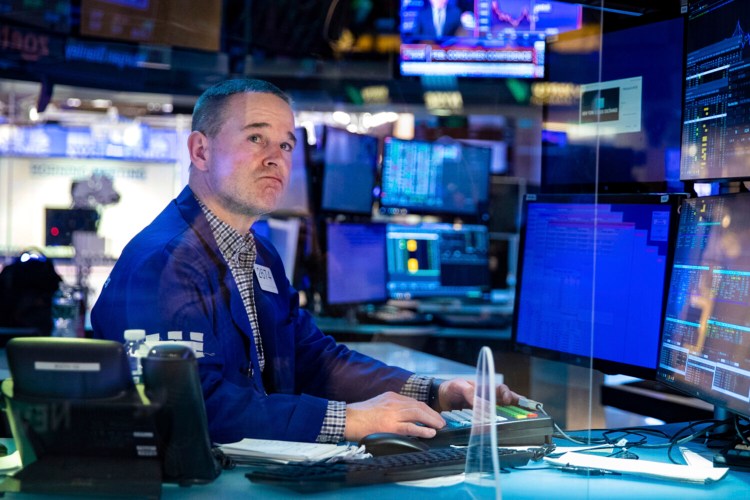All three major U.S. indexes dropped Tuesday as the escalating threat of war in Ukraine – and the beginning of economic sanctions from the United States and Europe – sent Wall Street reeling.
The Dow Jones industrial average slumped 482.57 points, or 1.4 percent, to close at 33,596.61. The broader S&P 500 index dropped 1 percent, or 44.11 points, to land at 4,304.76. The tech-centric Nasdaq fell 1.2 percent, or 166.55 points, to settle at 13,381.52.
Oil prices also moved higher after Russian President Vladimir Putin recognized the independence of two Moscow-backed separatist regions in eastern Ukraine and ordered Russian forces onto their territories for “peacekeeping” purposes.
The day was marked by those escalating tensions, as President Biden and European leaders announced economic sanctions against Moscow. Biden said the U.S. would begin targeting some financial institutions, Russian sovereign debt and Russian elites and their family members, after the White House cast Russia’s actions as “the beginning of an invasion.”
The European Union said it planned to target 351 members of Russia’s State Duma who voted for recognition, as well as “27 individuals and entities who are playing a role in undermining or threatening Ukrainian territorial integrity, sovereignty and independence,” E.U. foreign policy chief, Josep Borrell, announced Tuesday after a meeting of the bloc’s foreign ministers in Paris.
Cboe’s Volatility Index, known as Wall Street’s “fear gauge,” spiked 6 percent Tuesday according to MarketWatch.
The geopolitical stressors add a new dynamic to the volatility that has largely defined trading in 2022, according to Russ Mould, investment director at AJ Bell. Though the Russia-Ukraine crisis has been brewing for months, investors had been more focused on the potential fallout from a shift to tighter monetary policy as central banks around the world work to tamp down ballooning inflation.
“Now the threat of war is very real, and investors will need to add it to their growing list of things to worry about,” Mould said Tuesday in comments emailed to The Washington Post. “This could prompt another bout of panic and lead to heightened market volatility.”
Asian markets closed negative across the board, with Hong Kong’s Hang Seng Index shedding nearly 2.7 percent and Japan’s Nikkei 225 falling 1.7 percent. European indexes were mixed, with the benchmark Stoxx 600 closing barely positive and Germany’s DAX declining .25 percent.
Oil prices have moved off recent highs but remain elevated as investors awaited the fallout in global energy markets. On Tuesday, German Chancellor Olaf Scholtz announced that Berlin would halt the regulatory approval process for Nord Stream 2, a controversial gas pipeline project between Germany and Russia, in response to Moscow’s escalation in Ukraine. The move was applauded by the United Nations and NATO allies and cited as part of a united response to Russia.
Pavel Molchanov, an energy analyst with Raymond James, said that Russia produces roughly 10 percent of the world’s oil supply, on par with the United States and Saudi Arabia. While the worst-case scenario has yet to unfold in Ukraine, Molchanov said, “the possibility of further escalation is set to persist for a long time,” and that will put pressure on energy prices. In the event of all-out invasion, the impact would be more drastic.
“In the event of war, oil and gas pipelines would be at high risk of damage, even if neither side is targeting them deliberately,” Molchanov said in comments emailed to The Post. “Long after the war ends, Russia would face broad-based and harsh sanctions, which may include restrictions on energy exports.”
Brent crude, the international oil benchmark, was trading down about .45 percent, around $96.40 per barrel. West Texas Intermediate crude, the U.S. benchmark, was trading up more than 1.3 percent, around $92.30 per barrel.
Anthony Denier, chief executive of trading platform Webull, said sanctions against Russia will have “massive repercussions” for global markets.
“Russia and Ukraine are major exporters of a lot of commodities,” Denier noted Tuesday in comments emailed to The Post. “In addition to oil, Russia exports nearly half the palladium in the global market. It also exports gold, platinum and gas. If a conflict were to break out Russia’s exports would be reduced and Ukraine’s supply chains would be disrupted.”
Gold, an investor safe haven in times of turbulence, continued higher, nudging up nearly 0.2 percent to trade around $1,903.20 per troy ounce.
Beyond the cloud of geopolitical turmoil, investors were parsing fresh data that cast further light on inflation’s growing effect on prices. U.S. home prices grew at the fastest rate in 34 years in 2021, with the S&P CoreLogic Case-Shiller index registering an annual gain of 18.8 percent, according to data released Tuesday. Prices in Phoenix climbed more than 32 percent year-over-year, while price increases in Tampa and Miami neared 30 percent.
Comments are not available on this story.
Send questions/comments to the editors.


